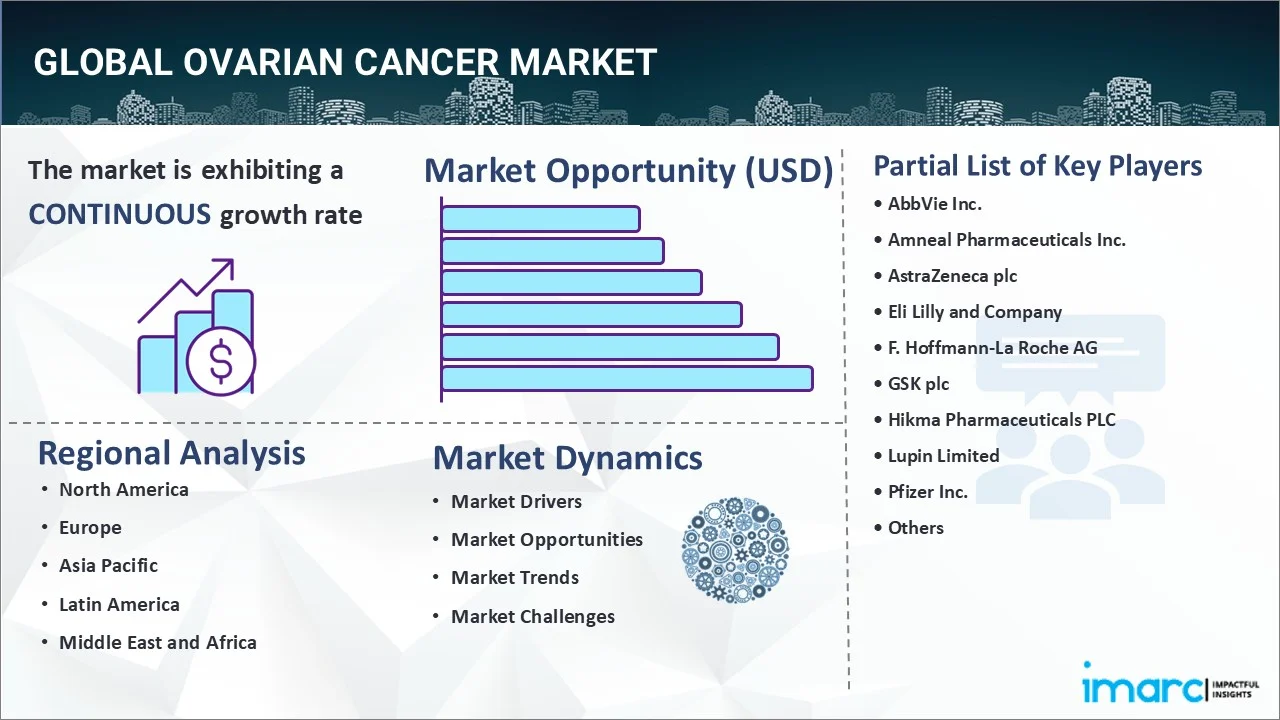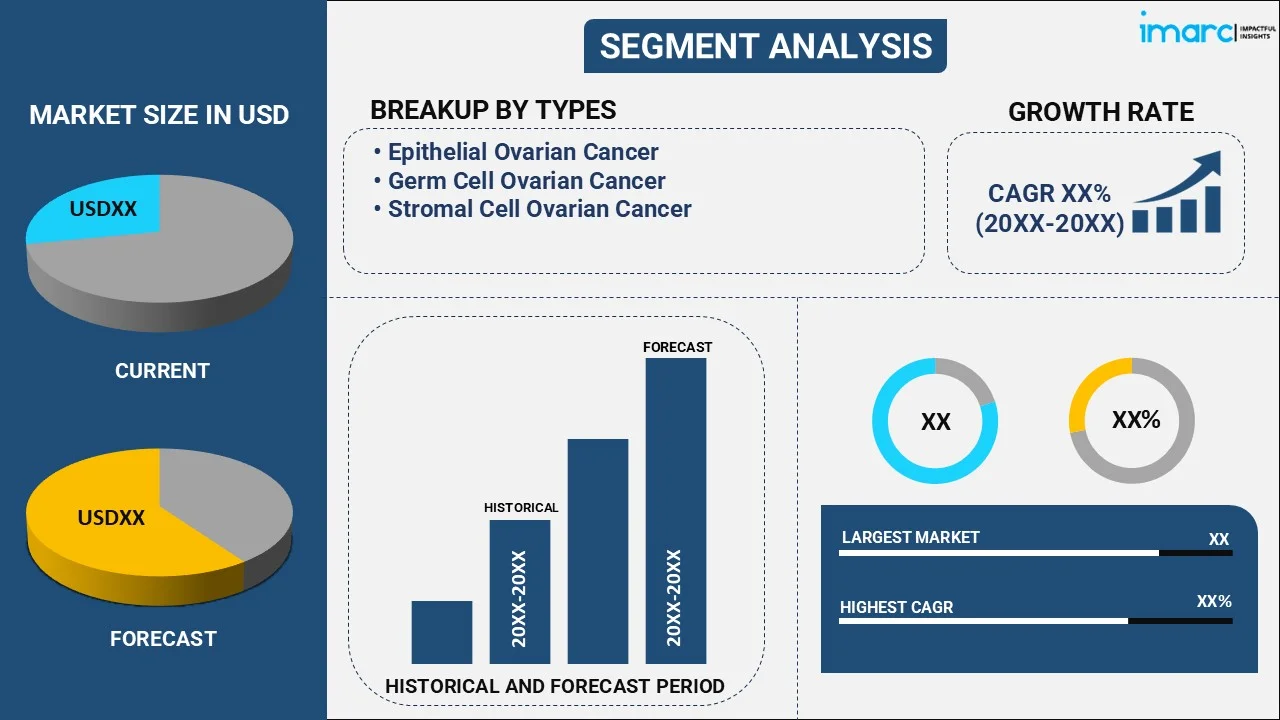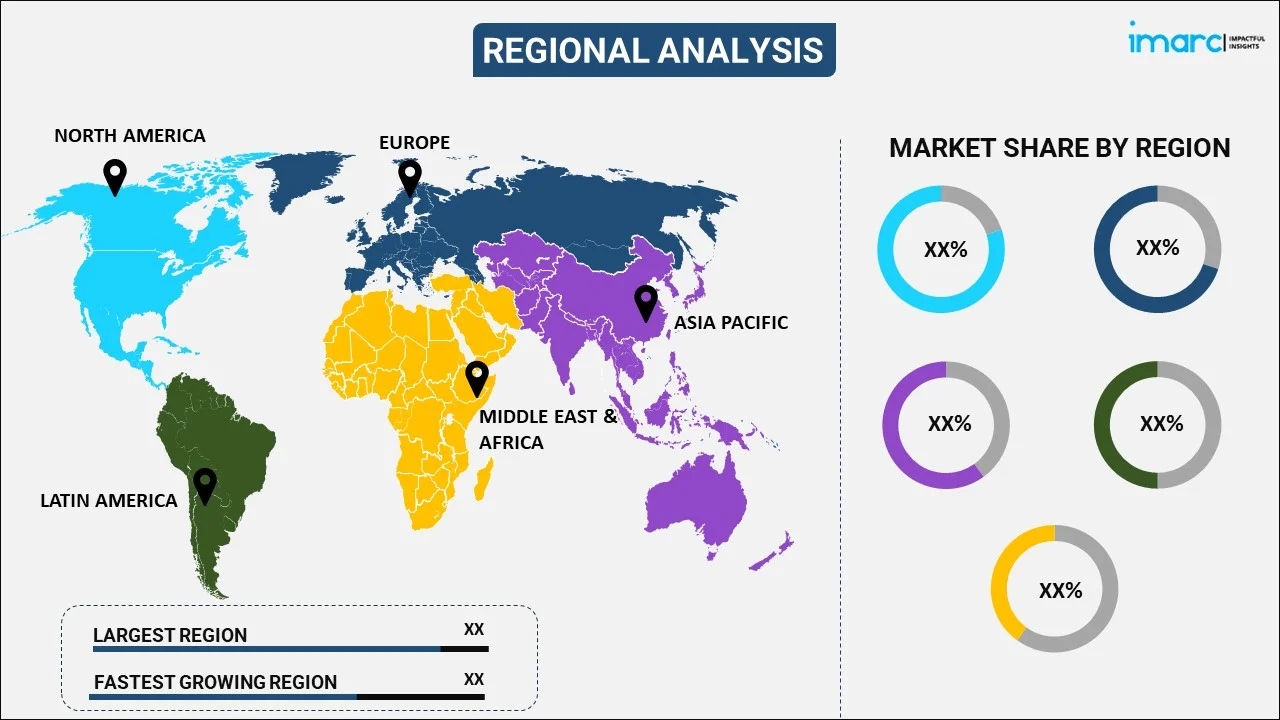
Ovarian Cancer Market Report by Type (Epithelial Ovarian Cancer, Germ Cell Ovarian Cancer, Stromal Cell Ovarian Cancer), Treatment Type (Immunotherapy, Chemotherapy, Targeted Therapy, Surgery, and Others), End User (Hospitals, Homecare, Speciality Centre, and Others), and Region 2025-2033
Market Overview:
The global ovarian cancer market size reached USD 2.3 Billion in 2024. Looking forward, IMARC Group expects the market to reach USD 5.5 Billion by 2033, exhibiting a growth rate (CAGR) of 9.59% during 2025-2033. The rising incidence of ovarian cancer cases, the emergence of personalized medicine in cancer care, and the implementation of government Initiatives to raise awareness, promote early detection, and support research represent some of the key factors driving the market.
|
Report Attribute
|
Key Statistics
|
|---|---|
|
Base Year
|
2024
|
|
Forecast Years
|
2025-2033
|
|
Historical Years
|
2019-2024
|
|
Market Size in 2024
|
USD 2.3 Billion |
|
Market Forecast in 2033
|
USD 5.5 Billion |
| Market Growth Rate (2025-2033) | 9.59% |
Ovarian cancer is a type of cancer that begins in the ovaries, the female reproductive organs responsible for producing eggs and female hormones. It typically develops when abnormal cells in the ovaries grow and multiply uncontrollably, forming a tumor. There are different types of ovarian cancer, and they can be classified based on the specific cells from which they originate. The most common type is epithelial ovarian cancer, which arises from the surface of the ovary. Other less common types include germ cell tumors and stromal tumors, which develop from the cells that produce eggs and hormones, respectively. Common symptoms of ovarian cancer include abdominal bloating, pelvic or abdominal pain, difficulty eating or feeling full quickly, frequent urination, and changes in bowel habits.

The market is driven by the increasing prevalence of ovarian cancer cases globally. The rising incidence of ovarian cancer has prompted healthcare providers and pharmaceutical companies to invest heavily in research and development to discover innovative therapies and targeted treatments. Moreover, advancements in medical technology and diagnostic techniques have led to early detection and diagnosis of ovarian cancer, enabling healthcare professionals to initiate treatment at earlier stages, improving patient outcomes, and enhancing survival rates. Besides, the growing awareness among the general population and healthcare professionals about the importance of regular screenings and early detection plays a crucial role in reducing mortality rates associated with ovarian cancer. Additionally, strategic collaborations and partnerships between pharmaceutical companies and research institutions have paved the way for the development of novel therapeutics and personalized treatment options. Furthermore, the rising investment in healthcare infrastructure and the availability of favorable reimbursement policies in several regions have encouraged patients to seek timely and comprehensive treatment for ovarian cancer.
Ovarian Cancer Market Trends/Drivers:
Growing prevalence of ovarian cancer
The escalating prevalence of ovarian cancer is a primary driver shaping the dynamics of the global ovarian cancer market. Ovarian cancer is one of the most common gynecologic malignancies affecting women worldwide. According to the World Health Organization (WHO), thousands of new cases are diagnosed each year, making it a significant health concern. The aging population and changing lifestyle patterns, including sedentary habits and unhealthy diets, have contributed to the rising incidence of ovarian cancer. As the population ages, the risk of developing ovarian cancer increases, further intensifying the demand for effective treatment options. This surge in ovarian cancer cases has spurred extensive research and development efforts by pharmaceutical companies and research institutions, which is influencing the market growth.
Technological advancements in medical technology and personalized medicine
Advancements in medical technology and personalized medicine have ushered in a new era in the management of ovarian cancer, constituting a significant driver in the market. Diagnostic tools and imaging modalities have evolved significantly, enabling early detection and accurate diagnosis of ovarian cancer. Transvaginal ultrasounds, magnetic resonance imaging (MRI), and serum biomarker tests, such as CA-125, have improved the chances of detecting ovarian cancer at its early stages, enhancing the prospects for successful treatment. Moreover, the rise of personalized medicine has transformed the approach to cancer treatment, including ovarian cancer. The development of targeted therapies and immunotherapies has revolutionized cancer care, offering tailored treatments that address the specific molecular and genetic characteristics of individual patients' tumors. These precision treatments have shown promising results in clinical trials, providing new hope for ovarian cancer patients who may have previously had limited treatment options.
Implementation of favorable reimbursement policies
The expansion of healthcare infrastructure and the presence of favorable reimbursement policies have played a pivotal role in driving the growth of the global ovarian cancer market. Governments and healthcare authorities in various countries are increasingly investing in bolstering healthcare facilities, including cancer treatment centers and oncology units. This development has significantly improved patient access to healthcare services, diagnosis, and treatment for ovarian cancer. Furthermore, favorable reimbursement policies have alleviated the financial burden on patients seeking cancer treatments. Reimbursement support for diagnostic tests, surgeries, chemotherapy, and targeted therapies has made treatment more affordable and accessible to a broader segment of the population.
Ovarian Cancer Industry Segmentation:
IMARC Group provides an analysis of the key trends in each segment of the global ovarian cancer market report, along with forecasts at the global, regional and country levels from 2025-2033. Our report has categorized the market based on type, treatment type and end user.
Breakup by Type:

- Epithelial Ovarian Cancer
- Germ Cell Ovarian Cancer
- Stromal Cell Ovarian Cancer
Epithelial ovarian cancer represents the leading type
The report has provided a detailed breakup and analysis of the market based on the type. This includes epithelial ovarian cancer, germ cell ovarian cancer, and stromal cell ovarian cancer. According to the report, epithelial ovarian cancer represented the largest segment.
Epithelial ovarian cancer is more commonly diagnosed in older women, and as the global population ages, the incidence of ovarian cancer tends to increase. The risk of developing ovarian cancer rises significantly after menopause, making postmenopausal women more susceptible to this type of cancer. Moreover, obesity and unhealthy lifestyle choices, such as poor diet and lack of physical activity, have been associated with an increased risk of ovarian cancer. The global rise in obesity rates over the past few decades may have contributed to the growing prevalence of epithelial ovarian cancer. Besides, certain genetic mutations, such as BRCA1 and BRCA2 mutations, are known to increase the risk of developing ovarian cancer. Inherited genetic factors can play a significant role in the prevalence of epithelial ovarian cancer, especially in families with a history of the disease.
Breakup by Treatment Type:
- Immunotherapy
- Chemotherapy
- Targeted Therapy
- Surgery
- Others
Immunotherapy is the most popular treatment type
A detailed breakup and analysis of the market based on the treatment type has also been provided in the report. This includes lateral flow assays, dipsticks, microfluidics, molecular diagnostics, and immunoassays. According to the report, lateral flow assays hold the largest market share.
Immunotherapy has emerged as a revolutionary approach in cancer treatment, showing promising results in various cancer types. Ovarian cancer, being one of the deadliest gynecological malignancies, has been a focus of research to identify novel and more effective therapies. Immunotherapy's success in other cancer types has generated significant interest in exploring its potential benefits in ovarian cancer treatment. Moreover, immunotherapy focuses on targeting the tumor microenvironment, which includes various immune cells and signaling molecules that support tumor growth and progression. By modulating the immune response, immunotherapy aims to create an inhospitable environment for cancer cells, hindering their growth and spread.
Breakup by End User:
- Hospitals
- Homecare
- Speciality Centre
- Others
The report has provided a detailed breakup and analysis of the market based on end user. This includes hospitals, homecare, speciality centre, and others.
Hospitals are the primary healthcare institutions that play a crucial role in the diagnosis, treatment, and management of ovarian cancer. They offer a comprehensive range of medical services, including surgery, chemotherapy, radiation therapy, and supportive care for ovarian cancer patients. Hospitals typically have specialized oncology departments or cancer centers equipped with advanced medical technology and a multidisciplinary team of healthcare professionals, including oncologists, surgeons, nurses, and support staff.
Homecare services may include nursing care, administration of medications, pain management, wound care, and assistance with activities of daily living. Homecare is particularly beneficial for patients who require ongoing support and monitoring but prefer to receive treatment in a familiar environment. Homecare services aim to enhance the quality of life for ovarian cancer patients, allowing them to remain in their homes while receiving necessary medical attention.
Specialty centers are dedicated healthcare facilities that focus on specific medical conditions or diseases, including ovarian cancer. These centers offer specialized expertise, state-of-the-art facilities, and advanced treatment options tailored to the needs of ovarian cancer patients. Specialty centers include oncology clinics, cancer institutes, and women's health centers that provide comprehensive care, support, and access to cutting-edge therapies and clinical trials for ovarian cancer.
Breakup by Region:

- North America
- United States
- Canada
- Asia-Pacific
- China
- Japan
- India
- South Korea
- Australia
- Indonesia
- Others
- Europe
- Germany
- France
- United Kingdom
- Italy
- Spain
- Russia
- Others
- Latin America
- Brazil
- Mexico
- Others
- Middle East and Africa
North America accounts for the majority of market share
The report has also provided a comprehensive analysis of all the major regional markets, which include North America (United States, Canada); Asia-Pacific (China, Japan, India, South Korea, Australia, Indonesia, Others); Europe (Germany, France, United Kingdom, Italy, Spain, Russia, Others); Latin America (Brazil, Mexico, Others); and the Middle East and Africa. According to the report, North America accounted for the largest market share.
North America boasts a well-established and technologically advanced healthcare infrastructure, with a high concentration of hospitals, specialty centers, and cancer institutes equipped with state-of-the-art medical facilities and cutting-edge technologies. This enables efficient diagnosis, treatment, and follow-up care for ovarian cancer patients. Moreover, the region is a hub for biomedical research and development, with numerous pharmaceutical and biotechnology companies conducting extensive research on cancer therapies, including ovarian cancer. Ongoing research and clinical trials contribute to the development of innovative treatment options and novel drugs, making North America a frontrunner in ovarian cancer treatment advancements.
Competitive Landscape:
The competitive landscape of the ovarian cancer market is characterized by a mix of pharmaceutical companies, biotechnology firms, and academic institutions actively engaged in research, development, and commercialization of treatments and therapies. These companies are developing and commercializing chemotherapy drugs, targeted therapies, and immunotherapies for ovarian cancer treatment. They are also focusing on novel drug development and personalized treatment options. Moreover, various companies are identifying new drug targets, exploring combination therapies, and conducting clinical trials to assess the safety and efficacy of their investigational drugs. They are also forming strategic partnerships with academic institutions, research organizations, and other biopharmaceutical firms to access complementary expertise, resources, and technologies.
The report has provided a comprehensive analysis of the competitive landscape in the market. Detailed profiles of all major companies have also been provided. Some of the key players in the market include:
- AbbVie Inc.
- Amneal Pharmaceuticals Inc.
- AstraZeneca plc
- Eli Lilly and Company
- F. Hoffmann-La
- Roche AG
- GSK plc
- Hikma Pharmaceuticals PLC
- Lupin Limited
- Pfizer Inc.
- Teva Pharmaceutical Industries Ltd.
Recent Developments:
- In September 2022, AstraZeneca and Merck jointly declared that Lynparza (olaparib) had received approval in China for the maintenance treatment of adult patients diagnosed with advanced epithelial ovarian, fallopian tube, or primary peritoneal cancer. This approval applies specifically to patients who have shown a complete or partial response to 1st-line platinum-based chemotherapy in combination with bevacizumab and whose cancer is associated with homologous recombination deficiency (HRD)-positive status.
- In September 2022, Pfizer and Strata Oncology announced an expansion of their partnership to include a clinical trial that will evaluate multiple cancer therapies in novel, biomarker-guided patient cohorts.
- Tesaro, which is now part of GlaxoSmithKline (GSK), launched "Zejula" (niraparib), another PARP inhibitor, for the treatment of ovarian cancer. Zejula is indicated for maintenance treatment in women with recurrent ovarian cancer who have responded to platinum-based chemotherapy.
Ovarian Cancer Market Report Scope:
| Report Features | Details |
|---|---|
| Base Year of the Analysis | 2024 |
| Historical Period | 2019-2024 |
| Forecast Period | 2025-2033 |
| Units | Billion USD |
| Scope of the Report | Exploration of Historical and Forecast Trends, Industry Catalysts and Challenges, Segment-Wise Historical and Predictive Market Assessment:
|
| Types Covered | Epithelial Ovarian Cancer, Germ Cell Ovarian Cancer, Stromal Cell Ovarian Cancer |
| Treatment Types Covered | Immunotherapy, Chemotherapy, Targeted Therapy, Surgery, Others |
| End Users Covered | Hospitals, Homecare, Speciality Centre, Others |
| Regions Covered | Asia Pacific, Europe, North America, Latin America, Middle East and Africa |
| Countries Covered | United States, Canada, Germany, France, United Kingdom, Italy, Spain, Russia, China, Japan, India, South Korea, Australia, Indonesia, Brazil, Mexico |
| Companies Covered | AbbVie Inc., Amneal Pharmaceuticals Inc., AstraZeneca plc, Eli Lilly and Company, F. Hoffmann-La Roche AG, GSK plc, Hikma Pharmaceuticals PLC, Lupin Limited, Pfizer Inc., Teva Pharmaceutical Industries Ltd., etc. |
| Customization Scope | 10% Free Customization |
| Post-Sale Analyst Support | 10-12 Weeks |
| Delivery Format | PDF and Excel through Email (We can also provide the editable version of the report in PPT/Word format on special request) |
Key Questions Answered in This Report:
- How has the global ovarian cancer market performed so far, and how will it perform in the coming years?
- What are the drivers, restraints, and opportunities in the global ovarian cancer market?
- What is the impact of each driver, restraint, and opportunity on the global ovarian cancer market?
- What are the key regional markets?
- Which countries represent the most attractive ovarian cancer market?
- What is the breakup of the market based on types?
- Which is the most attractive types in the ovarian cancer market?
- What is the breakup of the market based on treatment type?
- Which is the most attractive treatment type in the ovarian cancer market?
- What is the breakup of the market based on the end user?
- Which is the most attractive end user in the ovarian cancer market?
- What is the competitive structure of the global ovarian cancer market?
- Who are the key players/companies in the global ovarian cancer market?
Key Benefits for Stakeholders:
- IMARC’s report offers a comprehensive quantitative analysis of various market segments, historical and current market trends, market forecasts, and dynamics of the ovarian cancer market from 2019-2033.
- The research study provides the latest information on the market drivers, challenges, and opportunities in the global ovarian cancer market.
- The study maps the leading, as well as the fastest-growing, regional markets. It further enables stakeholders to identify the key country-level markets within each region.
- Porter's five forces analysis assist stakeholders in assessing the impact of new entrants, competitive rivalry, supplier power, buyer power, and the threat of substitution. It helps stakeholders to analyze the level of competition within the ovarian cancer industry and its attractiveness.
- Competitive landscape allows stakeholders to understand their competitive environment and provides an insight into the current positions of key players in the market.
Need more help?
- Speak to our experienced analysts for insights on the current market scenarios.
- Include additional segments and countries to customize the report as per your requirement.
- Gain an unparalleled competitive advantage in your domain by understanding how to utilize the report and positively impacting your operations and revenue.
- For further assistance, please connect with our analysts.
 Inquire Before Buying
Inquire Before Buying
 Speak to an Analyst
Speak to an Analyst
 Request Brochure
Request Brochure
 Request Customization
Request Customization




.webp)




.webp)












